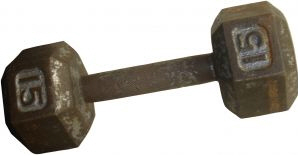 Two pieces of any good fitness program that are usually overlooked are warming up and cooling down. But, although most people like to skip past both, they play an important role in any program and especially a weight lifting program.
Two pieces of any good fitness program that are usually overlooked are warming up and cooling down. But, although most people like to skip past both, they play an important role in any program and especially a weight lifting program.
Warming up will help to reduce your risk of injury, increase the blood supply to the muscles during lifting which supplies the area with oxygen and nutrients. Warming up will help you to lift more and for a greater length of time because the muscles are primed and ready to go.
Cooling down will help your body to gradually recover from the strength training and keep the blood moving to the muscles, which also helps to remove the metabolic waste material after an exercise program. By removing those waste products, you’ll reduce the overall amount of soreness you feel the next day which will also improve the likelihood you’ll keep training and not throw in the towel.
A combination of warming up before working out and cooling down will also help to reduce your overall risk of injury to the muscles. Taking your body from a stiff position of sitting for hours to immediately pumping iron will increase the risk of injury. Large amounts of metabolic waste material in the muscles will also be more difficult to mobilize without taking the time to cool down and keep a generous blood supply to the area.

People who are doing a cardiovascular fitness program will often do the exact program at a reduced pace to warm up. However, weight lifters require another plan. Get on the treadmill, walking or jogging, for 5 minutes; use the elliptical trainer for 5 minutes at a mild to moderate pace; use a rowing machine which is especially helpful on the days you are working your upper body or go for a quick swim in the pool to loosen all your joints and warm up the muscles.
When finished, you can do the same activities noted above again for 5-10 minutes to keep the blood supply moving to the areas of the body you just worked. This helps to deliver needed oxygen and nutrients and helps the body to remove chemicals and toxins produced during the strength training.
Resources:
MayoClinic: How to warm up and cool down
http://www.mayoclinic.org/healthy-living/fitness/in-depth/exercise/art-20045517
BrianMac Warm Up and Cool Down
http://www.brianmac.co.uk/warmup.htm
Australian Government: The Warm Up and Cool Down
http://www.ausport.gov.au/participating/coaches/tools/the_training_session/Warmup-Cooldown
My Dr. Warming up and cooling down for exercise
http://www.mydr.com.au/sports-fitness/warming-up-and-cooling-down-for-exercise
American Heart Association: Warm Up, Cool Down
American Academy of Orthopedic Surgeons: Warm Up, Cool Down and Be Flexible
http://orthoinfo.aaos.org/topic.cfm?topic=a00310


Leave a Reply